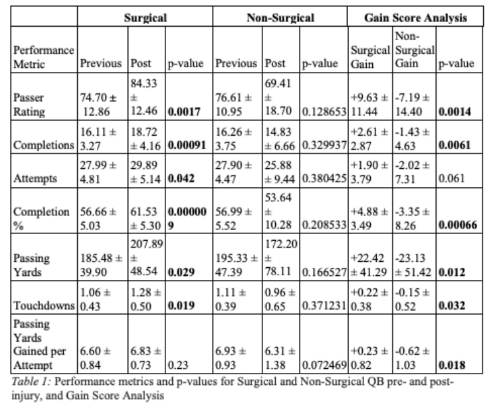Performance Outcomes in NFL Quarterbacks Following Shoulder Injury
View on GitHub 
Introduction
Shoulder injuries are among the most common types of upper extremity injuries in both contact and noncontact sports. They are a significant source of morbidity for athletes, accounting for almost one third of all sports-related injuries (Enger). As a result of these factors, shoulder injuries and their post healing metrics are an important area for research in orthopaedics.
Shoulder injuries most commonly result from direct trauma or a fall onto the ipsilateral shoulder, making athletes especially prone to these types of injuries (Monica). Some of the most common injuries in this population include anterior and posterior glenohumeral instability, acromioclavicular pathology (including separation, osteolysis, and osteoarthritis) and rotator cuff tears (Gibbs). Acromioclavicular joint injuries are the most common among the athletic population with an overall incidence rate of 9.2 per 1000 person-years and an average time of 18.4 days lost per athlete (Pallis) followed by Glenohumeral instability at at 2.79 per 1000 person-years (Lanzi).
With American football being a high contact sport played at high speeds, the potential for shoulder injuries from minor sprains to career ending tears is significant. Nearly half of players at the NFL combined have reported a history of shoulder injury, with 34% requiring operative intervention (Kaplan). Quarterbacks are particularly affected by shoulder injuries due to their playing position being targeted by the opposing team on every play, and the associated throwing mechanics with their playing actions. Of all QB injuries reported, shoulder injuries are the 2nd most common at 15.2% (Kelly).
The purpose of this study was to determine (1) the general impact on performance metrics among NFL quarterbacks following shoulder injury and (2) the impact of surgical interventions to repair these injuries had on career outcomes using measures such as passer rating, yards ran, and successful passes. We hypothesized that quarterbacks in the national football league who injure their dominant shoulder will 1) have decreased performance metrics after surgery 2) those that get surgery will have better performance metrics compared to those that do not get surgery.
Methods
Overview
National Football League (NFL) Injured Reserve (IR) lists for the years 1980 to 2019 were pulled from Pro Sports Transactions and entries were queried to find quarterbacks who were placed on the IR with a shoulder injury.
50 quarterbacks were found to have long-term shoulder injuries, and a subset of these were selected who had first-time shoulder surgery on their dominant, throwing arm. Manual searches were performed to verify the nature of the injury and determine dates of surgery. Age-matched controls were selected with the following criteria:
- same years of experience
- same number of career seasons +/- 5
- same year of NFL play +/- 10
Detailed
Quarterbacks (QBs) who suffered a shoulder injury necessitating placement on the Injured Reserve (IR) list were identified. Placement on the IR indicates a long-term injury rendering players unable to play in the remainder of the season. Pro Sports Transactions IR data from 1980 to 2019 was extracted and entries were filtered for injuries using keywords “shoulder”, “labrum”, “rotator cuff”, “dislocation”, and “AC joint”. An additional manual search of news articles from the NFL, official team websites, and reputable news sources was performed to confirm surgery types and dates and obtain information about players who were placed on the IR without a description of their injury. 65 relevant injuries were found. Of these injuries, 14 were repeat injuries for the same player and 17 were injuries to the non-throwing arm, all of which were excluded. The remaining entries were excluded if the shoulder injury was characterized as a “bruise” or a “strain”, and therefore not serious enough injuries to evaluate. Clavicle injuries were also excluded. Players who did not return to play in more than 1 regular season game were excluded for the performance analysis. A total of 19 QBs who received surgery and 11 QBs who suffered a severe shoulder injury but did not receive surgery were included.
QB performance statistics were extracted from Pro Football Reference, which includes statistics by game for players’ entire careers. 269 QBs from 1980 to 2020 were found and used as the entire NFL population of QBs. Included performance statistics were selected to be passer rating, passing yards, pass attempts, pass completions, pass completion percentage, passing touchdowns, interceptions, sacks, yards lost to sacks, yards per pass attempt, adjusted yards per pass attempt. Performance statistics were included only if the player attempted more than 1 pass in a game, and statistics were averaged for each game.
Unique age and experience matched controls were selected for each QB who underwent surgery. Controls were matched for experience by finding the set of QBs who started in the NFL at the same age. Using surgery dates and birth dates, a surgery age was calculated for each case QB, which was then used as an index age for possible controls. Pre-injury performance was measured by averaging the Passer Rating per game prior to injury, and finding the control QBs with the closest averaged Passer Rating prior to the index age. Passer Rating was selected as the primary performance statistic due to aggregating other important quarterback statistics and its prevalent usage (NFL Quarterback, NFL Passer Career, Katz, NCAA, Siwoff) in comparing quarterbacks since 1973 (NFL’s, Siwoff). Controls were also selected to have played their first NFL game +/- 10 years from the first NFL game played by the case QB. The list of age, experience, performance, and season matched controls were then selected by those with similar career lengths and 3+ games played previous and post index age. Surgical QB performance vs Surgical Control QB performance was then also visually compared by plotting performance statistics over career length to confirm appropriate controls. The same control matching process was used to find unique controls for QBs who did not receive surgical intervention, with an injury date used as the index, to produce the Non-Surgical QBs and the Non-Surgical Control QBs.
Normality of performance statistics in the entire population of NFL QBs, as well as in the case and control groups were assessed visually with Q-Q and histogram plots, to establish significance in any deviation from the mean in statistical analyses (Morgan). Performance statistics were compared previous and post surgery or injury for the case QBs. Performance statistics were then compared for Surgical and Non-Surgical QBs and their respective controls, prior to surgery, injury, or index age. A gain score analysis (Knapp) on the change in performance pre- and post-injury or index was performed on the case QBs vs control QBs.
Two sample t-tests were performed for each of these sets of statistics, with a paired t-test on the case QBs pre- and post-surgery or injury, and unpaired t-tests for comparisons between case and control QBs. The t-tests were calculated using the Stats package of SciPy 1.6.0 (Virtanen). The null hypothesis for all tests was that the means of compared populations were not significantly different. An alpha of 0.05 was selected, requiring p-values to be below this threshold to reject the null hypothesis. Plots were created using Matplotlib 3.4.2 (Hunter).
Exploratory Data Analysis
Here is the EDA, built using scraped data from publicly available NFL performance metrics and Jupyter Notebook. Data was cleaned and loaded into individual CSV files for every available qualifying quarterback, prior to this step of the EDA.
import numpy as np
import pandas as pd
import math
from math import pi
from datetime import time, datetime
from os import path
from scipy import stats
from scipy.stats import shapiro
from statsmodels.stats.power import TTestIndPower
from matplotlib import pyplot as plt
import seaborn as sns
%matplotlib inline
sns.set()
red = (255/255,103/255,103/255)
blue = (52/255,128/255,255/255)
Load Data
First we load our list of QBs, that we have downloaded and selected in the other notebook:
case_qbs = pd.read_csv('qb-data/case_qbs.csv')
ctrl_qbs = pd.read_csv('qb-data/ctrl_qbs.csv')
inj_qbs = pd.read_csv('qb-data/injured_qbs.csv')
select_ctrls = {'Alex Smith': 'Michael Vick',
'Andrew Luck': 'Joe Flacco',
'Cam Newton': 'Robert Griffin III',
'Chad Pennington': 'Tony Romo',
'Don Majkowski': 'Erik Kramer',
'Drew Brees': 'Peyton Manning',
'Jay Cutler': 'Matt Schaub',
'Jim McMahon': 'Jim Everett',
'Jimmy Clausen': 'Kellen Clemens',
'Kelly Holcomb': 'Donald Hollas',
'Mark Sanchez': 'Kyle Orton',
'Matt Moore': 'Geno Smith',
'Matthew Stafford': 'Drew Bledsoe',
'Rich Gannon': 'Tommy Kramer',
'Ryan Leaf': 'Tim Couch',
'Steve McNair': 'Donovan McNabb',
'Tom Brady': 'Brett Favre',
'Troy Aikman': 'John Elway',
'Gary Danielson': 'Jim Kelly'}
inj_ctrls = {'Marc Bulger': 'Shaun Hill',
'Derek Anderson': 'Matt Cassel',
'Kyle Boller': 'Blaine Gabbert',
'Bruce Gradkowski': 'Brady Quinn',
'Jameis Winston': 'Josh Freeman',
'Ben Roethlisberger': 'Aaron Rodgers',
'Jim Miller': 'Hugh Millen',
'Scott Mitchell': 'Doug Johnson',
'Gary Hogeboom': 'Steve Grogan',
'David Archer': 'Todd Blackledge',
'Tony Eason': 'Jeff Hostetler'}
Methods to access our CSV files of performance statistics:
def underscore(name):
sep = name.find(' ')
return name[:sep]+'_'+name[sep+1:]
def get_qb_stats(name, attempts=1, average=False):
filesuff = '{}.csv'.format(underscore(name))
if path.exists('qb-data/case/'+filesuff):
df = pd.read_csv('qb-data/case/'+filesuff)
elif path.exists('qb-data/control/'+filesuff):
df = pd.read_csv('qb-data/control/'+filesuff)
else:
return
df = df[df['Att']>attempts]
df.reset_index(drop=True, inplace=True)
if average:
return df.mean()
return df
get_qb_stats('Tom Brady', average=False).tail()
| Year | Date | Age | Cmp | Att | Cmp% | Yds | TD | Int | Rate | Sk | Yds.1 | Y/A | AY/A | |
|---|---|---|---|---|---|---|---|---|---|---|---|---|---|---|
| 295 | 2020 | 2020-11-23 | 43.112 | 26.0 | 48.0 | 54.17 | 216.0 | 2.0 | 2.0 | 62.5 | 1.0 | 7.0 | 4.50 | 3.46 |
| 296 | 2020 | 2020-11-29 | 43.118 | 27.0 | 41.0 | 65.85 | 345.0 | 3.0 | 2.0 | 96.1 | 1.0 | 3.0 | 8.41 | 7.68 |
| 297 | 2020 | 2020-12-13 | 43.132 | 15.0 | 23.0 | 65.22 | 196.0 | 2.0 | 0.0 | 120.9 | 0.0 | 0.0 | 8.52 | 10.26 |
| 298 | 2020 | 2020-12-20 | 43.139 | 31.0 | 45.0 | 68.89 | 390.0 | 2.0 | 0.0 | 110.4 | 3.0 | 25.0 | 8.67 | 9.56 |
| 299 | 2020 | 2020-12-26 | 43.145 | 22.0 | 27.0 | 81.48 | 348.0 | 4.0 | 0.0 | 158.3 | 1.0 | 7.0 | 12.89 | 15.85 |
Methods to select QB games by date, selecting all games or # of games before or after the date:
def format_date(date):
month_i = date.find('/', 3)
day_i = date.find('/')
month = date[:day_i]
day = date[day_i+1:month_i]
if len(day)==1:
day = '0'+day
if len(month)==1:
month = '0'+month
newdate = date[-4:]+'-'+month+'-'+day
return newdate
def get_qb_games(name, date, all_games=False, games=0, average=False, before=False, after=False):
df = get_qb_stats(name)
if df is None:
return
if '/' in date:
date = format_date(date)
i = 0
for d in df['Date']:
if d>=date:
break
else:
i+=1
if all_games:
if before and not after:
df = df.iloc[0:i,:].reset_index(drop=True)
elif after and not before:
df = df.iloc[i:,:].reset_index(drop=True)
else:
if before:
before_i = 0 if i-games<0 else i-games
df = df.iloc[before_i:i,:].reset_index(drop=True)
elif after:
df = df.iloc[i:i+games,:].reset_index(drop=True)
else:
df = df.iloc[i-games:i+games,:].reset_index(drop=True)
if average:
newdf = pd.DataFrame(data={'Games': len(df), 'Age': [df['Age'].mean()], 'Cmp': [df['Cmp'].mean()], 'Att': [df['Att'].mean()], 'Cmp%': [df['Cmp%'].mean()], 'Yds': [df['Yds'].mean()], 'TD': [df['TD'].mean()], 'Int': [df['Int'].mean()], 'Rate': [df['Rate'].mean()], 'Sk': [df['Sk'].mean()], 'Yds.1': [df['Yds.1'].mean()], 'Y/A': [df['Y/A'].mean()], 'AY/A': [df['AY/A'].mean()]})
return newdf
else:
return df
get_qb_games('Tom Brady', '12/30/2015', games=10, before=True)
| Year | Date | Age | Cmp | Att | Cmp% | Yds | TD | Int | Rate | Sk | Yds.1 | Y/A | AY/A | |
|---|---|---|---|---|---|---|---|---|---|---|---|---|---|---|
| 0 | 2015 | 2015-10-25 | 38.083 | 34.0 | 54.0 | 62.96 | 355.0 | 2.0 | 0.0 | 94.3 | 3.0 | 18.0 | 6.57 | 7.31 |
| 1 | 2015 | 2015-10-29 | 38.087 | 26.0 | 38.0 | 68.42 | 356.0 | 4.0 | 0.0 | 133.2 | 2.0 | 14.0 | 9.37 | 11.47 |
| 2 | 2015 | 2015-11-08 | 38.097 | 26.0 | 39.0 | 66.67 | 299.0 | 2.0 | 1.0 | 96.0 | 0.0 | 0.0 | 7.67 | 7.54 |
| 3 | 2015 | 2015-11-15 | 38.104 | 26.0 | 42.0 | 61.90 | 334.0 | 2.0 | 1.0 | 92.8 | 3.0 | 5.0 | 7.95 | 7.83 |
| 4 | 2015 | 2015-11-23 | 38.112 | 20.0 | 39.0 | 51.28 | 277.0 | 1.0 | 1.0 | 72.3 | 1.0 | 6.0 | 7.10 | 6.46 |
| 5 | 2015 | 2015-11-29 | 38.118 | 23.0 | 42.0 | 54.76 | 280.0 | 3.0 | 0.0 | 99.3 | 3.0 | 18.0 | 6.67 | 8.10 |
| 6 | 2015 | 2015-12-06 | 38.125 | 29.0 | 56.0 | 51.79 | 312.0 | 3.0 | 2.0 | 71.4 | 4.0 | 24.0 | 5.57 | 5.04 |
| 7 | 2015 | 2015-12-13 | 38.132 | 22.0 | 30.0 | 73.33 | 226.0 | 2.0 | 0.0 | 116.8 | 3.0 | 29.0 | 7.53 | 8.87 |
| 8 | 2015 | 2015-12-20 | 38.139 | 23.0 | 35.0 | 65.71 | 267.0 | 2.0 | 0.0 | 107.7 | 2.0 | 14.0 | 7.63 | 8.77 |
| 9 | 2015 | 2015-12-27 | 38.146 | 22.0 | 31.0 | 70.97 | 231.0 | 1.0 | 1.0 | 89.6 | 2.0 | 10.0 | 7.45 | 6.65 |
Method to get QB stats before or after a specified QB age:
def get_qb_stats_by_age(name, age, all_games=True, n_games=0, before=False, after=False):
stats = get_qb_stats(name)
if stats is None:
return
for a in stats['Age']:
if a>age:
qb_age = a
break
if age>a:
return
qb_date = stats[stats['Age']==qb_age]['Date'].to_string(index=False)[:]
if all_games:
if after:
result = get_qb_games(name, qb_date, all_games=True, average=True, after=True)
else:
result = get_qb_games(name, qb_date, all_games=True, average=True, before=True)
else:
if after:
result = get_qb_games(name, qb_date, games=n_games, average=False, after=True)
else:
result = get_qb_games(name, qb_date, games=n_games, average=True, before=True)
return result
get_qb_stats_by_age('Tom Brady', 27.5, all_games=True, before=True)
| Games | Age | Cmp | Att | Cmp% | Yds | TD | Int | Rate | Sk | Yds.1 | Y/A | AY/A | |
|---|---|---|---|---|---|---|---|---|---|---|---|---|---|
| 0 | 64 | 25.580125 | 19.421875 | 31.53125 | 60.684063 | 217.578125 | 1.515625 | 0.8125 | 86.8625 | 2.03125 | 12.296875 | 6.84875 | 6.680781 |
Now we can get our case qbs and their controls average stats before and after their surgery age, or respective index age:
def compile_before_after(caseslist, controlslist):
compare_qbs = pd.DataFrame()
for i, row in caseslist.iterrows():
case_prev = get_qb_stats_by_age(row.Name, row.SurgeryAge, before=True)
case_post = get_qb_stats_by_age(row.Name, row.SurgeryAge, after=True)
ctrl_prev = get_qb_stats_by_age(controlslist[row.Name], row.SurgeryAge, before=True)
ctrl_post = get_qb_stats_by_age(controlslist[row.Name], row.SurgeryAge, after=True)
case = case_prev.append(case_post)
case['Name'] = row.Name
ctrl = ctrl_prev.append(ctrl_post)
ctrl['Name'] = controlslist[row.Name]
compare_qbs = compare_qbs.append(case)
compare_qbs = compare_qbs.append(ctrl)
compare_qbs.reset_index(drop=True, inplace=True)
cols = list(compare_qbs.columns)
cols = cols[-1:] + cols[:-1]
compare_qbs = compare_qbs[cols]
return compare_qbs
cases_and_controls = compile_before_after(case_qbs, select_ctrls)
cases_and_controls.head()
| Name | Games | Age | Cmp | Att | Cmp% | Yds | TD | Int | Rate | Sk | Yds.1 | Y/A | AY/A | |
|---|---|---|---|---|---|---|---|---|---|---|---|---|---|---|
| 0 | Alex Smith | 30 | 22.115333 | 14.500000 | 26.600000 | 55.359667 | 155.966667 | 0.633333 | 1.033333 | 65.130000 | 2.666667 | 16.600000 | 5.914000 | 4.574667 |
| 1 | Alex Smith | 140 | 30.130007 | 19.942857 | 31.142857 | 64.533857 | 220.021429 | 1.271429 | 0.542857 | 92.314286 | 2.485714 | 13.842857 | 7.185571 | 7.294429 |
| 2 | Michael Vick | 43 | 22.765023 | 11.906977 | 22.209302 | 53.791163 | 153.930233 | 0.837209 | 0.604651 | 78.306977 | 2.534884 | 15.093023 | 6.885116 | 6.555116 |
| 3 | Michael Vick | 85 | 29.514729 | 15.211765 | 26.552941 | 57.080353 | 186.352941 | 1.141176 | 0.729412 | 82.440000 | 2.423529 | 14.435294 | 7.050353 | 6.871059 |
| 4 | Andrew Luck | 70 | 24.857086 | 22.428571 | 37.871429 | 59.812429 | 272.542857 | 1.885714 | 0.971429 | 88.327143 | 2.228571 | 14.142857 | 7.285571 | 7.185143 |
Lets split them up into individual DataFrames for now:
def get_case_control_prev_post(caseslist, controlslist):
compare = compile_before_after(caseslist, controlslist)
droplist = []
for i in range(len(compare)):
if i not in range(3,len(compare),4):
droplist.append(i)
ctrl_post = compare.drop(index=droplist)
droplist = []
for i in range(len(compare)):
if i not in range(2,len(compare),4):
droplist.append(i)
ctrl_prev = compare.drop(index=droplist)
droplist = []
for i in range(len(compare)):
if i not in range(1,len(compare),4):
droplist.append(i)
case_post = compare.drop(index=droplist)
droplist = []
for i in range(len(compare)):
if i not in range(0,len(compare),4):
droplist.append(i)
case_prev = compare.drop(index=droplist)
ctrl_post.reset_index(drop=True, inplace=True)
ctrl_prev.reset_index(drop=True, inplace=True)
case_post.reset_index(drop=True, inplace=True)
case_prev.reset_index(drop=True, inplace=True)
return case_prev, case_post, ctrl_prev, ctrl_post
case_prev, case_post, ctrl_prev, ctrl_post = get_case_control_prev_post(case_qbs, select_ctrls)
case_prev.head()
| Name | Games | Age | Cmp | Att | Cmp% | Yds | TD | Int | Rate | Sk | Yds.1 | Y/A | AY/A | |
|---|---|---|---|---|---|---|---|---|---|---|---|---|---|---|
| 0 | Alex Smith | 30 | 22.115333 | 14.500000 | 26.600000 | 55.359667 | 155.966667 | 0.633333 | 1.033333 | 65.130000 | 2.666667 | 16.600000 | 5.914000 | 4.574667 |
| 1 | Andrew Luck | 70 | 24.857086 | 22.428571 | 37.871429 | 59.812429 | 272.542857 | 1.885714 | 0.971429 | 88.327143 | 2.228571 | 14.142857 | 7.285571 | 7.185143 |
| 2 | Cam Newton | 93 | 24.641366 | 18.387097 | 31.483871 | 58.929032 | 234.107527 | 1.462366 | 0.838710 | 88.080645 | 2.376344 | 18.290323 | 7.569247 | 7.420538 |
| 3 | Chad Pennington | 41 | 26.918659 | 17.512195 | 26.609756 | 63.908537 | 197.341463 | 1.292683 | 0.658537 | 93.358537 | 1.634146 | 10.000000 | 7.691707 | 7.488293 |
| 4 | Don Majkowski | 44 | 24.859818 | 16.704545 | 30.113636 | 53.530909 | 208.659091 | 1.159091 | 1.045455 | 73.731818 | 2.727273 | 15.886364 | 6.847955 | 5.980909 |
inj_prev, inj_post, inj_ctrl_prev, inj_ctrl_post = get_case_control_prev_post(inj_qbs, inj_ctrls)
Output QB Stats
Get the QB passer rating prior to surgery:
case_prev[['Name','Rate']]
| Name | Rate | |
|---|---|---|
| 0 | Alex Smith | 65.130000 |
| 1 | Andrew Luck | 88.327143 |
| 2 | Cam Newton | 88.080645 |
| 3 | Chad Pennington | 93.358537 |
| 4 | Don Majkowski | 73.731818 |
| 5 | Drew Brees | 85.933898 |
| 6 | Jay Cutler | 86.086331 |
| 7 | Jim McMahon | 81.054000 |
| 8 | Jimmy Clausen | 56.384615 |
| 9 | Kelly Holcomb | 73.268421 |
| 10 | Mark Sanchez | 74.555738 |
| 11 | Matt Moore | 69.642105 |
| 12 | Matthew Stafford | 67.623077 |
| 13 | Rich Gannon | 70.777083 |
| 14 | Ryan Leaf | 41.180000 |
| 15 | Steve McNair | 81.100000 |
| 16 | Tom Brady | 84.741667 |
| 17 | Troy Aikman | 61.416000 |
| 18 | Gary Danielson | 76.981250 |
Get QB performance metric means and standard deviations:
cohort = inj_ctrl_post
for metric in ['Rate', 'Cmp', 'Att', 'Cmp%', 'Yds', 'TD', 'Int', 'Sk', 'Yds.1', 'Y/A', 'AY/A']:
print('%0.4f'%cohort[metric].mean()+' +/- '+'%0.4f'%cohort[metric].std())
76.9540 +/- 11.8350
14.7846 +/- 4.3202
25.9278 +/- 6.1679
56.0140 +/- 5.6810
173.4442 +/- 51.0495
0.9758 +/- 0.5093
0.7395 +/- 0.2855
1.9950 +/- 0.5334
13.2433 +/- 3.5240
6.5251 +/- 0.6900
5.9338 +/- 1.2980
Get difference in pre/post performance
for metric in ['Rate', 'Cmp', 'Att', 'Cmp%', 'Yds', 'TD', 'Int', 'Sk', 'Yds.1', 'Y/A', 'AY/A']:
diff = inj_ctrl_post[metric]-inj_ctrl_prev[metric]
print('%0.4f'%diff.mean()+' +/- '+'%0.4f'%diff.std())
-0.0600 +/- 6.6877
0.9437 +/- 4.7622
2.0128 +/- 7.6151
-1.3578 +/- 4.7623
9.0099 +/- 46.6216
-0.0240 +/- 0.3253
-0.1636 +/- 0.3235
-0.0432 +/- 1.0923
-0.0413 +/- 6.4434
-0.4008 +/- 0.5816
0.3455 +/- 1.3582
Output QB Tables
surg_qbs = case_qbs
surg_qbs['Control'] = list(select_ctrls.values())
new_cols = ['Name', 'Birthday', 'Year', 'Age', 'Surgery', 'SurgeryAge', 'Experience', 'Control']
surg_qbs = surg_qbs[new_cols]
surg_qbs.head()
| Name | Birthday | Year | Age | Surgery | SurgeryAge | Experience | Control | |
|---|---|---|---|---|---|---|---|---|
| 0 | Alex Smith | 5/7/1984 | 2005 | 21 | 11/6/2008 | 24.517808 | 3 | Michael Vick |
| 1 | Andrew Luck | 9/12/1989 | 2012 | 23 | 1/19/2017 | 27.372603 | 5 | Joe Flacco |
| 2 | Cam Newton | 5/11/1989 | 2011 | 22 | 3/30/2017 | 27.904110 | 6 | Robert Griffin III |
| 3 | Chad Pennington | 6/26/1976 | 2000 | 24 | 2/4/2005 | 28.630137 | 5 | Tony Romo |
| 4 | Don Majkowski | 2/25/1964 | 1987 | 23 | 12/13/1990 | 26.816438 | 3 | Erik Kramer |
nonsurg_qbs = inj_qbs
nonsurg_qbs['Control'] = list(inj_ctrls.values())
nonsurg_qbs = nonsurg_qbs[new_cols]
nonsurg_qbs.head()
| Name | Birthday | Year | Age | Surgery | SurgeryAge | Experience | Control | |
|---|---|---|---|---|---|---|---|---|
| 0 | Marc Bulger | 4/5/1977 | 2002 | 25 | 10/17/2005 | 28.553425 | 3 | Shaun Hill |
| 1 | Derek Anderson | 6/15/1983 | 2006 | 23 | 12/26/2006 | 23.547945 | 0 | Matt Cassel |
| 2 | Kyle Boller | 6/17/1981 | 2003 | 22 | 8/16/2008 | 27.183562 | 5 | Blaine Gabbert |
| 3 | Bruce Gradkowski | 1/27/1983 | 2006 | 23 | 11/28/2010 | 27.854795 | 4 | Brady Quinn |
| 4 | Jameis Winston | 1/6/1994 | 2015 | 21 | 10/15/2017 | 23.789041 | 2 | Josh Freeman |
surg_qbs.to_csv('qb-data/surg_qb_table.csv')
nonsurg_qbs.to_csv('qb-data/nonsurg_qb_table.csv')
Verify Normal Distribution
Lets take the whole population of NFL QBs - 269 in total, and look at the distribution of statistics:
def get_all_qb_career_stats(caseslist, controlslist):
all_qbs = get_qb_stats('Alex Smith', average=True)
all_qbs = all_qbs.to_frame().T
for i, row in caseslist.iterrows():
qb_stats = get_qb_stats(row.Name, average=True)
if i != 0:
all_qbs = all_qbs.append(qb_stats, ignore_index=True)
for i, row in controlslist.iterrows():
qb_stats = get_qb_stats(row.Name, average=True)
if stats is not None:
all_qbs = all_qbs.append(qb_stats, ignore_index=True)
return all_qbs
all_qb_stats = get_all_qb_career_stats(case_qbs, ctrl_qbs)
stat_names = {'Games': 'Games', 'Age': 'Age', 'Cmp': 'Pass Completions', 'Att': 'Pass Attempts', 'Cmp%': 'Pass Completion Percentage',
'Yds': 'Passing Yards', 'TD': 'Passing Touchdowns', 'Int': 'Interceptions', 'Rate': 'Passer Rating', 'Sk': 'Sacks',
'Yds.1': 'Yards Lost to Sacks', 'Y/A': 'Yards per Pass Attempt', 'AY/A': 'Adjusted Yards per Pass Attempt'}
def plot_hist_by_var(all_qbs, var):
plt.figure(figsize=(10,6))
mu, sigma = all_qbs[var].mean(), all_qbs[var].std()
n, bins, patches = plt.hist(all_qbs[var], 30, density=True, alpha=0.75, color=blue)
x = np.linspace(mu - 3*sigma, mu + 3*sigma, 100)
plt.plot(x, stats.norm.pdf(x, mu, sigma), color=red)
plt.xlabel(stat_names[var])
plt.ylabel('Frequency')
plt.title('Distribution of QB {}'.format(stat_names[var]))
plt.show()
We can see that the average Passer Rating for the entire population of NFL QBs follows a normal distribution quite well:
plot_hist_by_var(all_qb_stats, 'Rate')
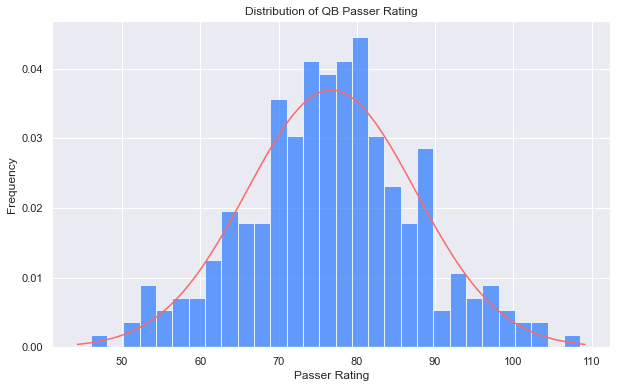
We can plug in other performance statistics we capture to check those too, let’s try pass attempts:
plot_hist_by_var(all_qb_stats, 'Att')
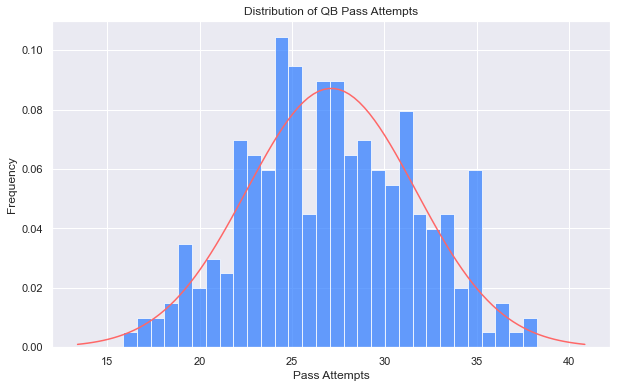
We can also check the distribution of our samples, the case and control QBs. We can do this using a Q-Q plot, which plots two sets of quantiles together so we can visually check if the dependent variable fits a normal distribution. This is important to verify so that we can make claims of statistically significant changes when performances deviate.
def probplot_by_var(qb_stats, var):
fig = plt.figure(figsize=(10,6))
ax = fig.add_subplot(111)
stats.probplot(qb_stats[var], plot=plt)
ax.get_lines()[0].set_markerfacecolor(blue)
ax.get_lines()[1].set_color(red)
plt.title('Probability Plot of {}'.format(stat_names[var]))
plt.show()
Here are our case QBs passer ratings, prior to surgery, on a Q-Q plot. We can visually see that they fit the normal distribution well.
probplot_by_var(case_prev, 'Rate')
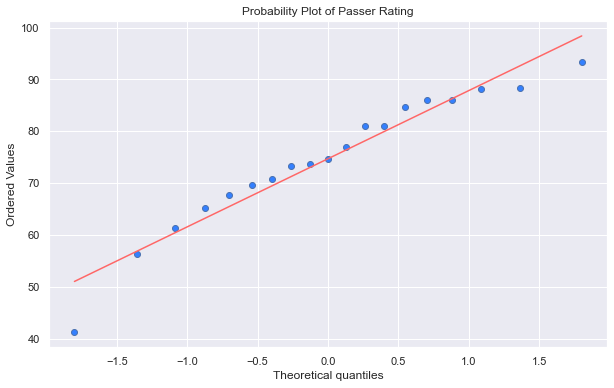
And all of our QBs:
cohorts = [case_prev, case_post, ctrl_prev, ctrl_post]
cohort_names = ['Surgical: Previous', 'Surgical: Post', 'Surgical Control: Previous', 'Surgical Control: Post']
fig = plt.figure(figsize=(12,8))
for i in range(4):
ax = fig.add_subplot(2,2,i+1)
stats.probplot(cohorts[i]['Rate'], plot=plt)
ax.get_lines()[0].set_markerfacecolor(blue)
ax.get_lines()[1].set_color(red)
ax.set_title(cohort_names[i])
plt.tight_layout(rect=[0, 0.03, 1, 0.95])
plt.suptitle('Surgical QB Probability Plots: Passer Rating')
plt.show()
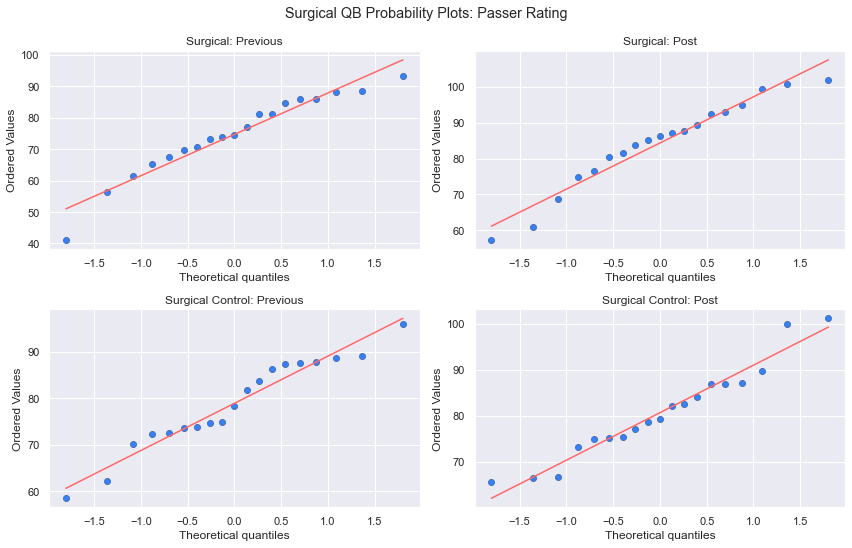
cohorts = [inj_prev, inj_post, inj_ctrl_prev, inj_ctrl_post]
cohort_names = ['Non-Surgical: Previous', 'Non-Surgical: Post', 'Non-Surgical Control: Previous', 'Non-Surgical Control: Post']
fig = plt.figure(figsize=(12,8))
for i in range(4):
ax = fig.add_subplot(2,2,i+1)
stats.probplot(cohorts[i]['Rate'], plot=plt)
ax.get_lines()[0].set_markerfacecolor(blue)
ax.get_lines()[1].set_color(red)
ax.set_title(cohort_names[i])
plt.tight_layout(rect=[0, 0.03, 1, 0.95])
plt.suptitle('Non-Surgical QB Probability Plots: Passer Rating')
plt.show()
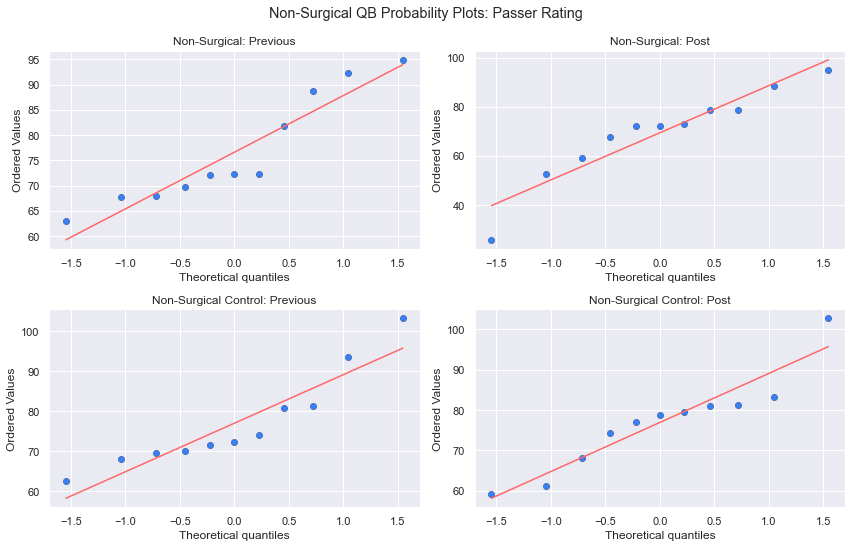
Shapiro-Wilk Test for Normality
stat, p = shapiro(all_qb_stats['Rate'])
print('Stat: '+str(stat)+' p-value: '+str(p))
Stat: 0.9963261485099792 p-value: 0.7873727679252625
stat, p = shapiro(inj_prev['AY/A'])
print('Stat: '+str(stat)+' p-value: '+str(p))
Stat: 0.9435199499130249 p-value: 0.562719464302063
QB Performance Statistics
Now lets take a closer look at the performance statistics of QBs. We are looking at passing statistics that are consistently recorded for all of our QBs going back to 1980, these are: Passer Rating (Rate), Completion Percentage (Cmp%), Passing Yards (Yds), Completions (Cmp), Attempts (Att), Yards per Pass Attempt (Y/A), Adjusted Yards per Pass Attempt (AY/A), Passing Touchdowns (TD), Interceptions (Int), Sacks (Sk), and Yards Lost to Sacks (Yds.1).
Passer Rating and Adjusted Yards per Attempt are calculations of several aggregated statistics.
Passer Rating is calculated as follows:
(a + b + c + d) / 6 * 100
where
a = (CMP/ATT - 0.3) * 5
b = (YDS/ATT - 3) * 0.25
c = (TD/ATT) * 20
d = 2.375 - (INT/ATT * 25)
Adjusted Yards per Pass Attempt is calculated as follows:
AY/A = (YDS + 20 * TD - 45 * INT) / ATT
We can find an easier way to look at a QB’s statistics than numbers on a chart, with a radial plot. Since statistics have very different ranges though, such as passing yards in the hundreds and interceptions per game less than 5, we have to look at these as percentages. Let’s calculate a QB’s statistics as a percentage of the population average.
def get_player_percent(player, df, all_qbs):
res = df[df['Name']==player]
res.set_index('Name', drop=True, inplace=True)
res.drop(columns=['Age', 'Games'], inplace=True)
res = res[['Rate', 'Cmp%', 'Yds', 'Cmp', 'Att', 'Y/A', 'AY/A', 'TD', 'Int', 'Sk', 'Yds.1']]
for var in res.columns:
avgvar = all_qbs[var].mean()
res[var] = res[var]/avgvar
return res
smith_prev = get_player_percent('Alex Smith', case_prev, all_qb_stats)
smith_post = get_player_percent('Alex Smith', case_post, all_qb_stats)
smith_prev
c:\anaconda3\lib\site-packages\pandas\core\frame.py:4308: SettingWithCopyWarning:
A value is trying to be set on a copy of a slice from a DataFrame
See the caveats in the documentation: https://pandas.pydata.org/pandas-docs/stable/user_guide/indexing.html#returning-a-view-versus-a-copy
return super().drop(
| Rate | Cmp% | Yds | Cmp | Att | Y/A | AY/A | TD | Int | Sk | Yds.1 | |
|---|---|---|---|---|---|---|---|---|---|---|---|
| Name | |||||||||||
| Alex Smith | 0.848928 | 0.970117 | 0.848582 | 0.922007 | 0.980547 | 0.882464 | 0.787074 | 0.603743 | 1.128319 | 1.263911 | 1.160729 |
Lets plot Alex Smith’s statistics before and after his surgery, as a percentage of the average NFL QB statistics.
def radar_plot(df1, df2, df3=None, df4=None, prevpost=False, max_val=1.5):
label1 = df1.index[0]+' (Previous)' if prevpost else df1.index[0]
label2 = df2.index[0]+' (Post)' if prevpost else df2.index[0]
if df3 is not None and df4 is not None:
plt.figure(figsize=(18,18))
ax = plt.subplot(121, polar=True)
else:
plt.figure(figsize=(14,8))
ax = plt.subplot(111, polar=True)
plt.title('{} vs {}: % of NFL Average'.format(label1, label2))
categories=list(df1)
N = len(categories)
angles = [n / float(N) * 2 * pi for n in range(N)]
angles += angles[:1]
plt.xticks(angles[:-1], categories, color='black', size=12)
ax.set_rlabel_position(0)
yticks = [max_val*i/6 for i in range(1,6)]
plt.yticks(yticks, [str(e) for e in yticks], color='grey', size=14)
plt.ylim(0,max_val)
colors = ['blue','red']
values1 = df1.values.flatten().tolist()
values1 += values1[:1]
ax.plot(angles, values1, linewidth=1, linestyle='solid', color=colors[0], label=label1)
ax.fill(angles, values1, color=colors[0], alpha=0.1)
values2 = df2.values.flatten().tolist()
values2 += values2[:1]
ax.plot(angles, values2, linewidth=1, linestyle='solid', color=colors[1], label=label2)
ax.fill(angles, values2, color=colors[1], alpha=0.1)
plt.legend(loc=0, bbox_to_anchor=(0.1, 0.1), prop={'size': 13})
if df3 is not None and df4 is not None:
plt.title('{} vs {}: Previous, % of NFL Average'.format(label1, label2))
ax = plt.subplot(122, polar=True)
plt.xticks(angles[:-1], categories, color='black', size=12)
ax.set_rlabel_position(0)
yticks = [max_val*i/6 for i in range(1,6)]
plt.yticks(yticks, [str(e) for e in yticks], color='grey', size=14)
plt.ylim(0,max_val)
values1 = df3.values.flatten().tolist()
values1 += values1[:1]
ax.plot(angles, values1, linewidth=1, linestyle='solid', color=colors[0], label=df3.index[0])
ax.fill(angles, values1, color=colors[0], alpha=0.1)
values2 = df4.values.flatten().tolist()
values2 += values2[:1]
ax.plot(angles, values2, linewidth=1, linestyle='solid', color=colors[1], label=df4.index[0])
ax.fill(angles, values2, color=colors[1], alpha=0.1)
plt.legend(loc=0, bbox_to_anchor=(0.1, 0.1), prop={'size': 13})
plt.title('{} vs {}: Post, % of NFL Average'.format(df3.index[0], df4.index[0]))
plt.show()
radar_plot(smith_prev, smith_post, prevpost=True)

Or we can compare two different QBs:
vick_prev = get_player_percent('Michael Vick', ctrl_prev, all_qb_stats)
c:\anaconda3\lib\site-packages\pandas\core\frame.py:4308: SettingWithCopyWarning:
A value is trying to be set on a copy of a slice from a DataFrame
See the caveats in the documentation: https://pandas.pydata.org/pandas-docs/stable/user_guide/indexing.html#returning-a-view-versus-a-copy
return super().drop(
radar_plot(smith_prev, vick_prev)
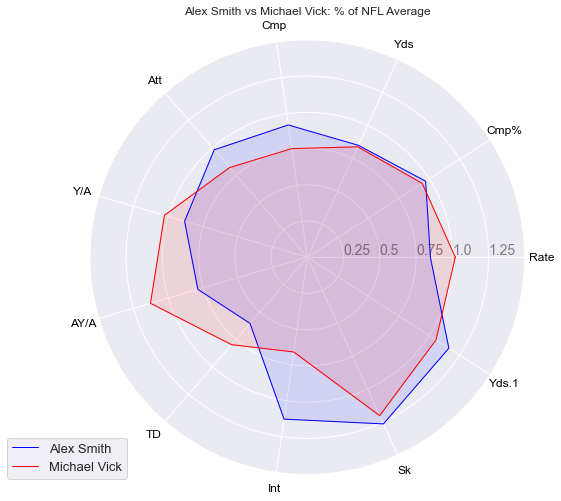
And now lets look at Alex Smith and his control, Michael Vick, for their previous and post surgery/index performances.
vick_post = get_player_percent('Michael Vick', ctrl_post, all_qb_stats)
radar_plot(smith_prev, vick_prev, smith_post, vick_post)
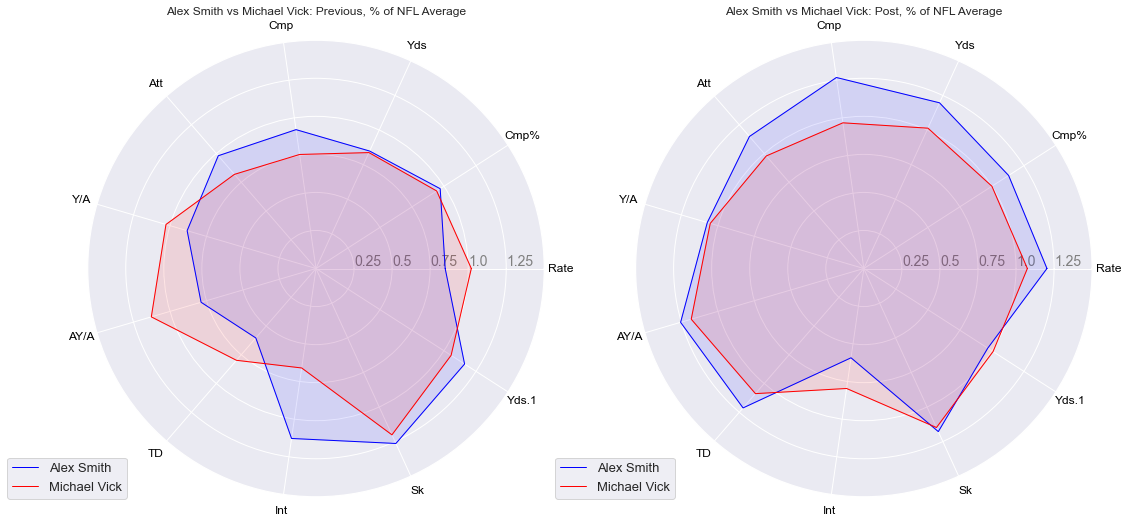
Case QBs Pre and Post Surgery
The next step is to examine the performance statistics of our case QBs before and after their surgeries. We can look at the cohort as a whole.
def plot_pre_post(case_prev, case_post, var):
var_conv = {'Rate': 9, 'Games': 1, 'Cmp': 3, 'Att': 4, 'Cmp%': 5, 'Yds': 6, 'TD': 7, 'Int': 8, 'Sk': 10, 'Yds.1': 11, 'Y/A': 12, 'AY/A': 13}
var_name = var
var = var_conv[var]
fig, (ax1, ax2) = plt.subplots(1,2,figsize=(10,6))
for i in range(len(case_prev)):
ax1.scatter(i/36, case_prev.iloc[i,var], color=blue, alpha=0.75)
ax1.scatter(1+i/36, case_post.iloc[i,var], color=red, alpha=0.75)
ax1.plot([0,0.5], [case_prev.iloc[:,var].mean(), case_prev.iloc[:,var].mean()], color=blue, linewidth=3)
ax1.plot([1,1.5], [case_post.iloc[:,var].mean(), case_post.iloc[:,var].mean()], color=red, linewidth=3)
ax1.set_xlim(-0.5,2)
ax1.set_xticks([.25,1.25])
ax1.set_xticklabels(['Previous', 'Post'])
ax1.set_ylabel(stat_names[var_name])
for i in range(len(case_prev)):
ax2.scatter(1, case_prev.iloc[i,var], color=blue, alpha=0.75)
ax2.scatter(2, case_post.iloc[i,var], color=red, alpha=0.75)
if case_post.iloc[i,var] - case_prev.iloc[i,var] > 0:
c = 'green'
else:
c = 'red'
ax2.plot([1, 2], [case_prev.iloc[i,var], case_post.iloc[i,var]], color=c, linewidth=0.5, alpha=0.5)
ax2.set_xlim(0.5,2.5)
ax2.set_xticks([1,2])
ax2.set_xticklabels(['Previous', 'Post'])
return ax1, ax2
plot_pre_post(case_prev, case_post, 'Rate')
plt.suptitle('Surgical QB Passer Rating')
plt.show()
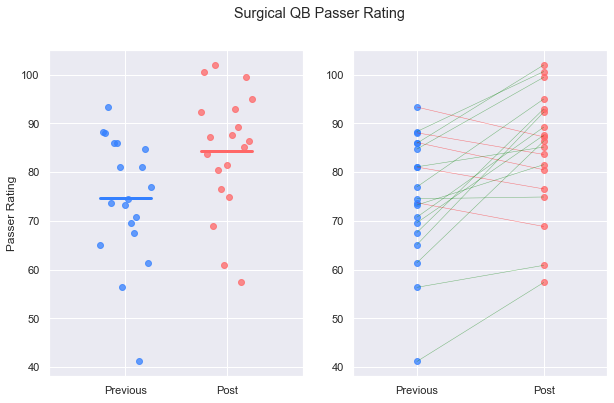
And their controls:
plot_pre_post(ctrl_prev, ctrl_post, 'Rate')
plt.suptitle('Surgical Control QB Passer Rating')
plt.show()
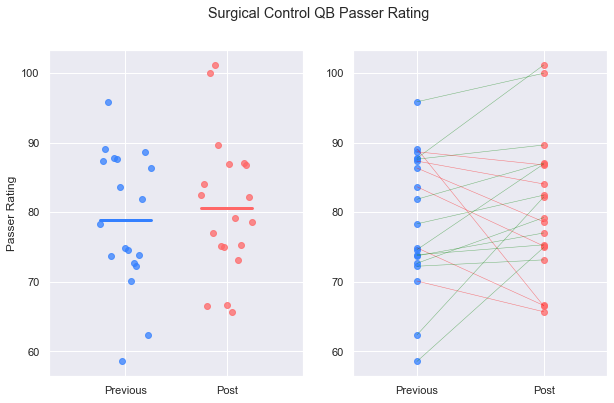
Compare that with the decline in performance seen in quarterbacks who did not have surgical intervention.
plot_pre_post(inj_prev, inj_post, 'Rate')
plt.suptitle('Non-Surgical QB Passer Rating')
plt.show()
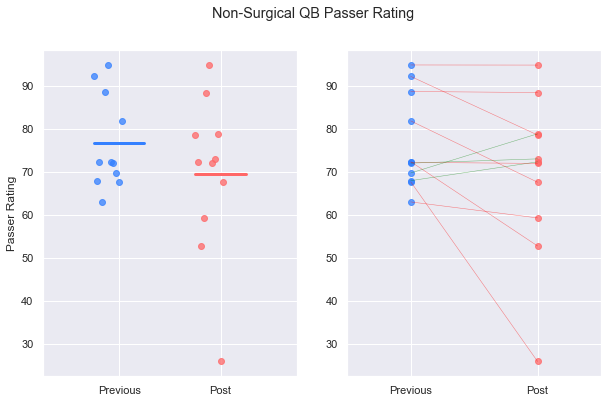
Non-surgical quarterback controls maintained their average performance over the same timespan.
plot_pre_post(inj_ctrl_prev, inj_ctrl_post, 'Rate')
plt.suptitle('Non-Surgical Control QB Passer Rating')
plt.show()
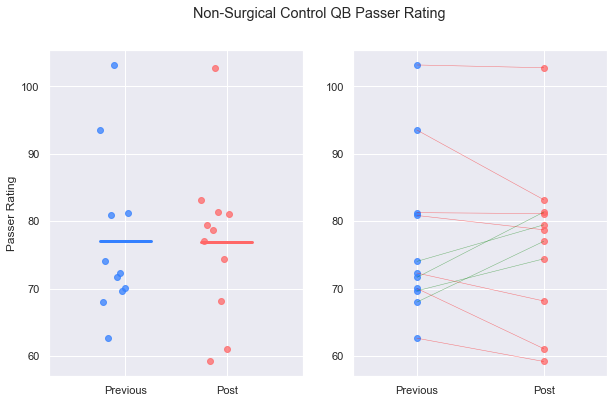
Plotting the groups on the same graph helps make comparisons.
def plot_case_control(case_prev, case_post, ctrl_prev, ctrl_post, var):
var_conv = {'Rate': 9, 'Games': 1, 'Cmp': 3, 'Att': 4, 'Cmp%': 5, 'Yds': 6, 'TD': 7, 'Int': 8, 'Sk': 10, 'Yds.1': 11, 'Y/A': 12, 'AY/A': 13}
var_name = var
var = var_conv[var]
length = len(case_prev)
fig, ax = plt.subplots(figsize=(10,6))
if len(case_prev)!=len(ctrl_prev):
for i in range(len(case_prev)):
ax.scatter(1.5+i/length, case_prev.iloc[i,var], color=red, alpha=0.75)
ax.scatter(6+i/length, case_post.iloc[i,var], color=red, marker='^', alpha=0.75)
for j in range(len(ctrl_prev)):
ax.scatter(3+j/length, ctrl_prev.iloc[j,var], color=blue, alpha=0.75)
ax.scatter(7.5+j/length, ctrl_post.iloc[j,var], color=blue, marker='^', alpha=0.75)
else:
for i in range(len(case_prev)):
ax.scatter(1.5+i/length, case_prev.iloc[i,var], color=red, alpha=0.75)
ax.scatter(3+i/length, ctrl_prev.iloc[i,var], color=blue, alpha=0.75)
ax.scatter(6+i/length, case_post.iloc[i,var], color=red, marker='^', alpha=0.75)
ax.scatter(7.5+i/length, ctrl_post.iloc[i,var], color=blue, marker='^', alpha=0.75)
ax.plot([1.5,2.5], [case_prev.iloc[:,var].mean(), case_prev.iloc[:,var].mean()], color=red, linewidth=3)
ax.plot([3,4], [ctrl_prev.iloc[:,var].mean(), ctrl_prev.iloc[:,var].mean()], color=blue, linewidth=3)
ax.plot([6,7], [case_post.iloc[:,var].mean(), case_post.iloc[:,var].mean()], color=red, linestyle=':',linewidth=3)
ax.plot([7.5,8.5], [ctrl_post.iloc[:,var].mean(), ctrl_post.iloc[:,var].mean()], color=blue, linestyle=':',linewidth=3)
ax.set_xlim(0,10)
ax.set_xticks([2.75, 7.25])
ax.set_xticklabels(['Previous', 'Post'])
ax.set_ylabel('{}'.format(stat_names[var_name]))
return ax
plot_case_control(case_prev, case_post, ctrl_prev, ctrl_post, 'Rate')
plt.title('Surgical vs Surgical Control Passer Rating')
plt.legend(['Surgical: Previous', 'Surgical Control: Previous', 'Surgical: Post', 'Surgical Control: Post'])
plt.show()
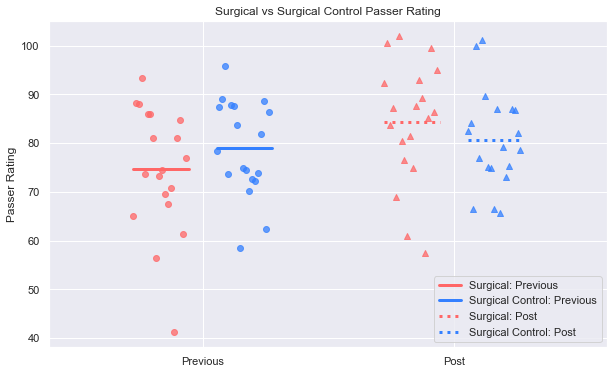
plot_case_control(case_prev, case_post, inj_prev, inj_post, 'Rate')
plt.title('Surgical vs Non-Surgical Passer Rating')
plt.legend(['Surgical: Previous', 'Non-Surgical: Previous', 'Surgical: Post', 'Non-Surgical: Post'])
plt.show()
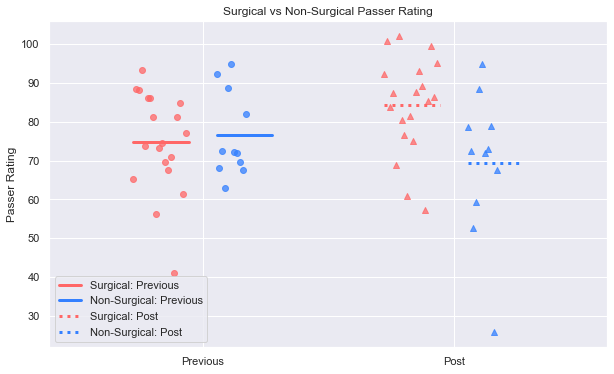
They can also be visualized on the same scale but with each cohort grouped to better understand the chart.
def plot_pre_post_two_cohorts(case_prev, case_post, ctrl_prev, ctrl_post, var):
var_conv = {'Rate': 9, 'Games': 1, 'Cmp': 3, 'Att': 4, 'Cmp%': 5, 'Yds': 6, 'TD': 7, 'Int': 8, 'Sk': 10, 'Yds.1': 11, 'Y/A': 12, 'AY/A': 13}
var_name = var
var = var_conv[var]
fig, (ax1, ax2) = plt.subplots(1,2,figsize=(10,6))
for i in range(len(case_prev)):
ax1.scatter(i/36, case_prev.iloc[i,var], color=blue, alpha=0.75)
ax1.scatter(1+i/36, case_post.iloc[i,var], color=red, alpha=0.75)
ax1.plot([0,0.5], [case_prev.iloc[:,var].mean(), case_prev.iloc[:,var].mean()], color=blue, linewidth=3)
ax1.plot([1,1.5], [case_post.iloc[:,var].mean(), case_post.iloc[:,var].mean()], color=red, linewidth=3)
ax1.set_xlim(-0.5,2)
ax1.set_ylim(20,110)
ax1.set_xticks([.25,1.25])
ax1.set_xticklabels(['Previous', 'Post'])
ax1.set_ylabel(stat_names[var_name])
for i in range(len(ctrl_prev)):
ax2.scatter(i/36, ctrl_prev.iloc[i,var], color=blue, alpha=0.75)
ax2.scatter(1+i/36, ctrl_post.iloc[i,var], color=red, alpha=0.75)
ax2.plot([0,0.5], [ctrl_prev.iloc[:,var].mean(), ctrl_prev.iloc[:,var].mean()], color=blue, linewidth=3)
ax2.plot([1,1.5], [ctrl_post.iloc[:,var].mean(), ctrl_post.iloc[:,var].mean()], color=red, linewidth=3)
ax2.set_xlim(-0.5,2)
ax2.set_ylim(20,110)
ax2.set_xticks([.25,1.25])
ax2.set_xticklabels(['Previous', 'Post'])
return ax1, ax2
ax1, ax2 = plot_pre_post_two_cohorts(case_prev, case_post, ctrl_prev, ctrl_post, 'Rate')
ax1.set_title('Surgical')
ax2.set_title('Surgical Control')
plt.show()
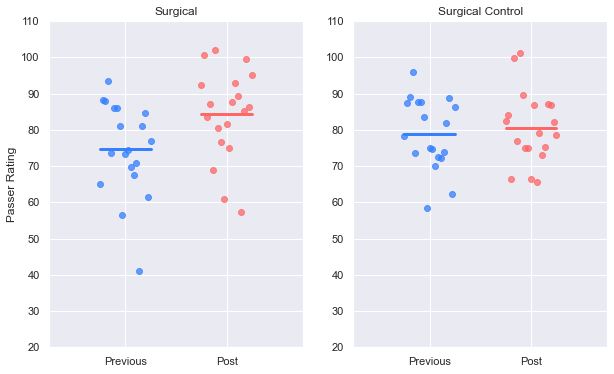
ax1, ax2 = plot_pre_post_two_cohorts(inj_prev, inj_post, inj_ctrl_prev, inj_ctrl_post, 'Rate')
ax1.set_title('Non-Surgical')
ax2.set_title('Non-Surgical Control')
plt.show()
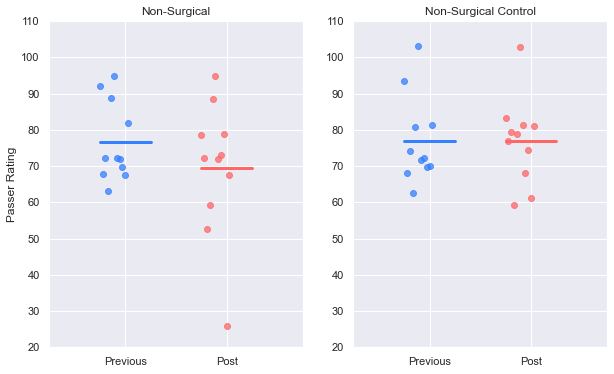
ax1, ax2 = plot_pre_post_two_cohorts(case_prev, case_post, inj_prev, inj_post, 'Rate')
ax1.set_title('Surgical')
ax2.set_title('Non-Surgical')
plt.show()
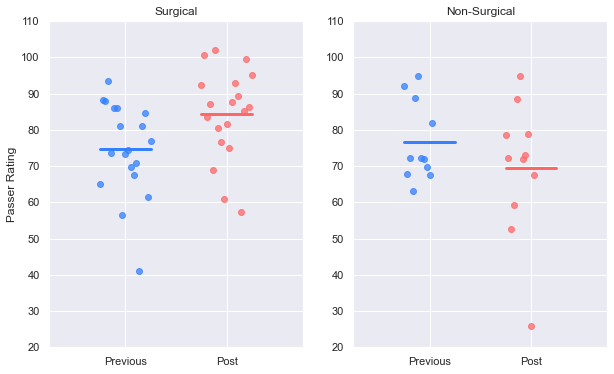
Statistical Analysis
We can output statistics by comparing cohorts using t-tests to identify statistically significant changes. The limiting factor of this data exploration is the small sample sizes. The NFL has very few quarterbacks playing substantial amounts of games at any given time, and fewer suffer serious shoulder injuries. Small sample sizes mean any comparison may not be appropriately powered to draw meaningful conclusions, so performing t-tests on individual statistics between cohorts should let us know if those conclusions are statistically significant.
def ttest_ind_gsa(case_prev, case_post, ctrl_prev, ctrl_post, var):
n = len(case_prev)
case_diff = case_post[var]-case_prev[var]
ctrl_diff = ctrl_post[var]-ctrl_prev[var]
diff = case_diff.mean()-ctrl_diff.mean()
sign = '+' if diff>0 else ''
ttest = stats.ttest_ind(case_diff, ctrl_diff);
print(var+' %1.6f'%ttest[1])
print('Case: %1.4f'%case_diff.mean()+' Control: %1.4f'%ctrl_diff.mean()+' Gain Score: '+sign+'%1.4f'%diff)
print(' n: %1d'%n+' t-value: %1.4f'%ttest[0]+' p-value: %1.6f'%ttest[1])
return(case_diff.mean()-ctrl_diff.mean(), ttest[1])
def ttest_rel_by_var(prev, post, var):
n = len(prev)
prev_mean = prev[var].mean()
post_mean = post[var].mean()
diff = post_mean-prev_mean
sign='+' if diff>0 else ''
ttest = stats.ttest_rel(prev[var], post[var])
print(var+' %1.6f'%ttest[1])
print('Previous: %1.4f'%prev_mean+' Post: %1.4f'%post_mean+' Difference: '+sign+'%1.4f'%diff)
print(' n: %1d'%n+' t-value: %1.4f'%ttest[0]+' p-value: %1.4f'%ttest[1])
return diff, ttest[1]
def ttest_ind_by_var(case, ctrl, var):
n = len(case)
case_mean = case[var].mean()
ctrl_mean = ctrl[var].mean()
diff = case_mean-ctrl_mean
sign = '+' if diff>0 else ''
ttest = stats.ttest_ind(case[var], ctrl[var])
print(var+' %1.6f'%ttest[1])
print('Case: %1.4f'%case_mean+' Control: %1.4f'%ctrl_mean+' Difference: '+sign+'%1.4f'%diff)
print(' n: %1d'%n+' t-value: %1.4f'%ttest[0]+' p-value: %1.4f'%ttest[1])
return diff, ttest[1]
def pooled_standard_deviation(sample1,sample2):
n1, n2 = len(sample1), len(sample2)
var1, var2 = np.var(sample1, ddof=1), np.var(sample2, ddof=1)
numerator = ((n1-1) * var1) + ((n2-1) * var2)
denominator = n1+n2-2
return np.sqrt(numerator/denominator)
def Cohens_d(sample1, sample2):
u1, u2 = np.mean(sample1), np.mean(sample2)
s_pooled = pooled_standard_deviation(sample1, sample2)
return ((u1 - u2) / s_pooled)
def calc_power(case_prev, case_post, ctrl_prev, ctrl_post, var='Rate', alpha=0.05, ratio=1):
case_diff = case_post[var]-case_prev[var]
ctrl_diff = ctrl_post[var]-ctrl_prev[var]
effect_size = Cohens_d(case_diff, ctrl_diff)
analysis = TTestIndPower()
power = analysis.solve_power(effect_size, power=None, nobs1=len(case_diff), ratio=ratio, alpha=alpha)
return power
var_list = ['Rate', 'Cmp', 'Att', 'Cmp%', 'Yds', 'TD', 'Int', 'Sk', 'Yds.1', 'Y/A', 'AY/A']
We can use a paired t-test to examine the effects of a shoulder injury and subsequent surgical or non-surgical intervention, since we are looking at the same related group at 2 different time points.
for var in var_list:
d, t = ttest_rel_by_var(ctrl_prev, ctrl_post, var)
# print(var, '%0.6f'%t)
Rate 0.461702
Previous: 78.9109 Post: 80.6392 Difference: +1.7282
n: 19 t-value: -0.7521 p-value: 0.4617
Cmp 0.916577
Previous: 16.7589 Post: 16.6298 Difference: -0.1292
n: 19 t-value: 0.1062 p-value: 0.9166
Att 0.599649
Previous: 28.7980 Post: 27.7740 Difference: -1.0240
n: 19 t-value: 0.5343 p-value: 0.5996
Cmp% 0.768927
Previous: 57.5311 Post: 57.9723 Difference: +0.4411
n: 19 t-value: -0.2983 p-value: 0.7689
Yds 0.727577
Previous: 198.5172 Post: 193.2015 Difference: -5.3158
n: 19 t-value: 0.3538 p-value: 0.7276
TD 0.698892
Previous: 1.2078 Post: 1.1704 Difference: -0.0374
n: 19 t-value: 0.3931 p-value: 0.6989
Int 0.727993
Previous: 0.9671 Post: 0.9202 Difference: -0.0469
n: 19 t-value: 0.3533 p-value: 0.7280
Sk 0.439128
Previous: 2.0988 Post: 1.9381 Difference: -0.1607
n: 19 t-value: 0.7912 p-value: 0.4391
Yds.1 0.414806
Previous: 13.8526 Post: 12.6836 Difference: -1.1690
n: 19 t-value: 0.8347 p-value: 0.4148
Y/A 0.700472
Previous: 6.8588 Post: 6.7502 Difference: -0.1086
n: 19 t-value: 0.3909 p-value: 0.7005
AY/A 0.811582
Previous: 6.1730 Post: 6.0977 Difference: -0.0753
n: 19 t-value: 0.2419 p-value: 0.8116
For example, we can see the p-values for each performance statistic we are looking at. For the case control quarterbacks, it looks like none of the values range from ~0.41 to ~0.92, which are well above the chosen threshold of 0.05 to achieve statistical significance. However, given that none of these quarterbacks suffered an injury, their respective timepoints are arbitrary and so their previous and post performances understandably do not show a correlation.
Now we can run the same t-test comparison on the case quarterbacks who DID have surgery:
for var in var_list:
d, t = ttest_rel_by_var(case_prev, case_post, var)
# print(var, '%0.6f'%t)
Rate 0.001764
Previous: 74.7038 Post: 84.3321 Difference: +9.6283
n: 19 t-value: -3.6670 p-value: 0.0018
Cmp 0.000914
Previous: 16.1113 Post: 18.7180 Difference: +2.6067
n: 19 t-value: -3.9620 p-value: 0.0009
Att 0.042101
Previous: 27.9853 Post: 29.8854 Difference: +1.9000
n: 19 t-value: -2.1880 p-value: 0.0421
Cmp% 0.000009
Previous: 56.6555 Post: 61.5307 Difference: +4.8753
n: 19 t-value: -6.0958 p-value: 0.0000
Yds 0.029363
Previous: 185.4761 Post: 207.8934 Difference: +22.4174
n: 19 t-value: -2.3667 p-value: 0.0294
TD 0.019184
Previous: 1.0627 Post: 1.2850 Difference: +0.2222
n: 19 t-value: -2.5723 p-value: 0.0192
Int 0.009196
Previous: 1.0079 Post: 0.8136 Difference: -0.1943
n: 19 t-value: 2.9173 p-value: 0.0092
Sk 0.314115
Previous: 2.1218 Post: 1.9864 Difference: -0.1354
n: 19 t-value: 1.0356 p-value: 0.3141
Yds.1 0.048746
Previous: 14.2028 Post: 12.5181 Difference: -1.6847
n: 19 t-value: 2.1139 p-value: 0.0487
Y/A 0.234517
Previous: 6.6000 Post: 6.8320 Difference: +0.2320
n: 19 t-value: -1.2300 p-value: 0.2345
AY/A 0.023223
Previous: 5.5597 Post: 6.4094 Difference: +0.8496
n: 19 t-value: -2.4806 p-value: 0.0232
Now we can see the p-values for the case group are much lower, and are under the 0.05 threshold for achieving statistical significance for the following: Passer Rating, Completions, Pass Attempts, Completion Percentage, Passing Yards, Touchdowns, Interceptions, Yards Lost to Sacks, and Adjusted Yards per Pass Attempt.
Next, rather than comparing one group at 2 timepoints, or 2 groups together at the same timepoint, we can attempt to compare the change in performance between groups. We can do so using a Gain Score Analysis, which takes the gain over the timepoint, or how much a group improved or declined, and compare that with the gain of another group. Here we can compare the change in performance for our case quarterbacks after surgery vs the change in performance of our control quarterbacks who were not injured.
for var in var_list:
ttest_ind_gsa(case_prev, case_post, ctrl_prev, ctrl_post, var)
Rate 0.029685
Case: 9.6283 Control: 1.7282 Gain Score: +7.9000
n: 19 t-value: 2.2642 p-value: 0.029685
Cmp 0.055496
Case: 2.6067 Control: -0.1292 Gain Score: +2.7359
n: 19 t-value: 1.9791 p-value: 0.055496
Att 0.173131
Case: 1.9000 Control: -1.0240 Gain Score: +2.9240
n: 19 t-value: 1.3898 p-value: 0.173131
Cmp% 0.012268
Case: 4.8753 Control: 0.4411 Gain Score: +4.4341
n: 19 t-value: 2.6371 p-value: 0.012268
Yds 0.127148
Case: 22.4174 Control: -5.3158 Gain Score: +27.7331
n: 19 t-value: 1.5615 p-value: 0.127148
TD 0.050775
Case: 0.2222 Control: -0.0374 Gain Score: +0.2596
n: 19 t-value: 2.0209 p-value: 0.050775
Int 0.327672
Case: -0.1943 Control: -0.0469 Gain Score: -0.1474
n: 19 t-value: -0.9923 p-value: 0.327672
Sk 0.917193
Case: -0.1354 Control: -0.1607 Gain Score: +0.0253
n: 19 t-value: 0.1047 p-value: 0.917193
Yds.1 0.750751
Case: -1.6847 Control: -1.1690 Gain Score: -0.5158
n: 19 t-value: -0.3201 p-value: 0.750751
Y/A 0.317221
Case: 0.2320 Control: -0.1086 Gain Score: +0.3406
n: 19 t-value: 1.0143 p-value: 0.317221
AY/A 0.053258
Case: 0.8496 Control: -0.0753 Gain Score: +0.9249
n: 19 t-value: 1.9985 p-value: 0.053258
We can also compare the change in quarterbacks who were injured and had surgery, vs those who were injured and did NOT have surgery:
for var in var_list:
ttest_ind_gsa(case_prev, case_post, inj_prev, inj_post, var)
Rate 0.001462
Case: 9.6283 Control: -7.1938 Gain Score: +16.8221
n: 19 t-value: 3.5289 p-value: 0.001462
Cmp 0.006175
Case: 2.6067 Control: -1.4288 Gain Score: +4.0355
n: 19 t-value: 2.9616 p-value: 0.006175
Att 0.061708
Case: 1.9000 Control: -2.0222 Gain Score: +3.9223
n: 19 t-value: 1.9464 p-value: 0.061708
Cmp% 0.000669
Case: 4.8753 Control: -3.3497 Gain Score: +8.2249
n: 19 t-value: 3.8256 p-value: 0.000669
Yds 0.012728
Case: 22.4174 Control: -23.1322 Gain Score: +45.5496
n: 19 t-value: 2.6618 p-value: 0.012728
TD 0.032769
Case: 0.2222 Control: -0.1478 Gain Score: +0.3700
n: 19 t-value: 2.2461 p-value: 0.032769
Int 0.361604
Case: -0.1943 Control: -0.0727 Gain Score: -0.1217
n: 19 t-value: -0.9275 p-value: 0.361604
Sk 0.726291
Case: -0.1354 Control: -0.2408 Gain Score: +0.1054
n: 19 t-value: 0.3536 p-value: 0.726291
Yds.1 0.620250
Case: -1.6847 Control: -2.6204 Gain Score: +0.9356
n: 19 t-value: 0.5011 p-value: 0.620250
Y/A 0.018463
Case: 0.2320 Control: -0.6221 Gain Score: +0.8541
n: 19 t-value: 2.5021 p-value: 0.018463
AY/A 0.021520
Case: 0.8496 Control: -0.7061 Gain Score: +1.5557
n: 19 t-value: 2.4350 p-value: 0.021520
We can see that there is a statistically significant difference in Passer Rating, Completions, Completion Percentage, Passing Yards, Touchdowns, Yards per Pass Attempt, and Adjusted Yards per Pass Attempt. This indicates there is a potential positive effect on quarterbacks who have surgical intervention following a shoulder injury vs those who are treated non-surgically.
Below is a table showing the average peformance metric +/- 1 SD for the cohort of quarterbacks who were injured and had surgery and those who were injured and did not have surgery. There is a p-value for each cohort’s previous and post performance, as well as the raw numbers of the gain score analysis and p-values associated with those.
calc_power(case_prev, case_post, ctrl_prev, ctrl_post)
0.5962222319545054
We can also calculate the power of this study. Statistical power is ideally greater than 0.80 for robust studies, but in small sample size studies it decreases. With a small sample size of NFL quarterbacks, it is expectedly underpowered, but it still allows for conclusions to be drawn. Comparing the case and control groups show the power of this t-test would be 0.5962. Comparable articles in the sports science literature have to use small sample sizes, for example Busfield et al. (https://www.arthroscopyjournal.org/article/S0749-8063(09)00193-5/fulltext).
Conclusion
Despite small sample sizes, detailed performance metrics of NFL quarterbacks have allowed use to analyze performances with regards to shoulder injury and surgery. We can draw preliminary conclusions from the data that quarterbacks who suffer severe shoulder injuries who are treated surgically, tend to have statistically significant improvements in performances upon their return, when compared to their prior performance, and the performance of quarterbacks who were similarly injured but treated non-surgically.
Further research may include examining greater sample sizes such as collegiate football quarterbacks, a wider range of performance metrics such as pass lengths, and stratification of cohorts based on specific shoulder injury.
There are many limitations to this exploratory analysis. Primarily, the sample size is small, and therefore the power of these statistical tests is smaller. This means that the effects of surgical and non-surgical intervention on quarterback performance should be looked into further, as the data is tending towards surgical intervention improving outcomes but at a very low sample size.
Further, there are numerous outside factors not considered here. Quarterback performances tend to improve with age up to a certain point, as players become more experienced. This could have confounding factors, such as quarterbacks who play more games getting injured more often, better quarterbacks being medically treated differently from other quarterbacks, quarterbacks retiring towards their peaks, etc.
There are also only a few selected statistics used to draw conclusions here, which will no doubt increase in the future as tracking these performance metrics becomes more common and detailed. There will be opportunities in the future to take advantage of these metrics, or even increase the sample size by looking at college football for example.
The data outputted from this exploratory data analysis has been used in the posters and pre-papers of “Performance Following Surgical and Non-surgical Management of Shoulder Injury in NFL Quarterbacks” by Frederick Durrant B.S., George Durrant M.Eng., Martinus Megalla B.A., Teja Makkapati B.A., Nareena Imam B.A., Rocco Bassora M.D., and Frank Alberta M.D., in conjunction with Hackensack Meridian School of Medicine and the Rothman Orthopedic Institute.
Appendix
Assorted graphs indicating NFL QB performance over time vs controls of the population of all NFL QBs in the dataset.
%matplotlib inline
sns.set()
red = (255/255,103/255,103/255)
# red = (.9, 0.4, 0.4)
blue = (52/255,128/255,255/255, 1)
# red = np.array([.9, .4, .4])
blue = np.array([.2, .4, .9])
red = np.array(red)
def plot_case_control_by_year(cases, controls, var):
plt.figure(figsize=(12,76))
for i, row in cases.iterrows():
plt.subplot(len(cases),1,i+1)
ctrl = controls[row.Name]
case_stats = get_qb_yearly_stats(row.Name)
ctrl_stats = get_qb_yearly_stats(ctrl)
case_prev = case_stats[case_stats['Age'] < row.SurgeryAge]
case_post = case_stats[case_stats['Age'] > row.SurgeryAge]
ctrl_prev = ctrl_stats[ctrl_stats['Age'] < row.SurgeryAge]
ctrl_post = ctrl_stats[ctrl_stats['Age'] > row.SurgeryAge]
labels= ['Case: Previous', 'Case: Post', 'Control: Previous', 'Control: Post', 'Surgery']
print(case_prev.Age.shape)
plt.scatter(case_prev.Age, case_prev['{}'.format(var)], c=red)
plt.plot(case_prev.Age, case_prev['{}'.format(var)], c=red, linewidth=0.5)
plt.scatter(case_post.Age, case_post['{}'.format(var)], c=red, marker='^')
plt.plot(case_post.Age, case_post['{}'.format(var)], c=red, linestyle='-.', linewidth=1)
plt.scatter(ctrl_prev.Age, ctrl_prev['{}'.format(var)], c=blue)
plt.plot(ctrl_prev.Age, ctrl_prev['{}'.format(var)], c=blue, linewidth=0.5)
plt.scatter(ctrl_post.Age, ctrl_post['{}'.format(var)], c=blue, marker='^')
plt.plot(ctrl_post.Age, ctrl_post['{}'.format(var)], c=blue, linestyle='-.', linewidth=1)
plt.axvline(x=row.SurgeryAge, color='green')
plt.plot([ctrl_prev.Age.values[-1],ctrl_post.Age.values[0]], [ctrl_prev['{}'.format(var)].values[-1],ctrl_post['{}'.format(var)].values[0]], color=blue, linestyle='-.',linewidth=0.5)
plt.legend(labels, fontsize='medium', loc='lower right')
plt.title('Case: {} vs Control: {}, for {} over Age'.format(row.Name, ctrl, var))
plt.ylabel('{}'.format(var))
plt.xlabel('Age')
plt.tight_layout()
plt.show()
def plot_case_pop_by_year(cases, all_controls, var):
plt.figure(figsize=(12,76))
for i, row in cases.iterrows():
plt.subplot(len(cases),1,i+1)
case_stats = get_qb_yearly_stats(row.Name)
ctrl_stats = all_controls
firstage = case_stats.iloc[0, 0]
lastage = case_stats.iloc[-1, 0]
case_prev = case_stats[case_stats['Age'] < row.SurgeryAge]
case_post = case_stats[case_stats['Age'] > row.SurgeryAge]
ctrl_prev = ctrl_stats[(ctrl_stats['Age'] < row.SurgeryAge) & (ctrl_stats['Age'] > firstage-1)]
ctrl_post = ctrl_stats[(ctrl_stats['Age'] > row.SurgeryAge) & (ctrl_stats['Age'] < lastage+1)]
labels= ['Case: Previous', 'Case: Post', 'Control: Previous', 'Control: Post', 'Surgery']
plt.scatter(case_prev.Age, case_prev['{}'.format(var)], color=red)
plt.plot(case_prev.Age, case_prev['{}'.format(var)], color=red, linewidth=0.5)
plt.scatter(case_post.Age, case_post['{}'.format(var)], color=red, marker='^')
plt.plot(case_post.Age, case_post['{}'.format(var)], color=red, linestyle='-.', linewidth=0.5)
plt.scatter(ctrl_prev.Age, ctrl_prev['{}'.format(var)], color=blue)
plt.plot(ctrl_prev.Age, ctrl_prev['{}'.format(var)], color=blue, linewidth=0.5)
plt.scatter(ctrl_post.Age, ctrl_post['{}'.format(var)], color=blue, marker='^')
plt.plot(ctrl_post.Age, ctrl_post['{}'.format(var)], color=blue, linestyle='-.', linewidth=0.5)
plt.plot([ctrl_prev.Age.values[-1],ctrl_post.Age.values[0]], [ctrl_prev['{}'.format(var)].values[-1],ctrl_post['{}'.format(var)].values[0]], color=blue, linestyle='-.', linewidth=0.5)
plt.axvline(x=row.SurgeryAge, color='green')
plt.legend(labels, fontsize='medium', loc='lower right')
plt.title('{} vs All Controls, for {} over Age'.format(row.Name, var))
plt.ylabel('{}'.format(var))
plt.xlabel('Age')
plt.tight_layout()
plt.show()
def plot_avg_var_by_year(df, var):
plt.figure(figsize=(18,6))
plt.scatter(df.Age, df['{}'.format(var)], c=df.Count, cmap='coolwarm')
plt.title('Average {} vs Age'.format(var))
plt.xlabel('Age')
plt.ylabel('{}'.format(var))
plt.colorbar()
if var=='Rate':
plt.ylim(50, 120)
plt.show()
def plot_case_ctrl_pop(case, ctrl, pop, var):
plt.figure(figsize=(16,6))
plt.scatter(case.Age, case['{}'.format(var)], color=red)
plt.plot(case.Age, case['{}'.format(var)], color=red, linewidth=0.5)
plt.scatter(ctrl.Age, ctrl['{}'.format(var)], color=blue, marker='^')
plt.plot(ctrl.Age, ctrl['{}'.format(var)], color=blue, linewidth=0.5)
plt.plot(pop.Age, pop['{}'.format(var)], color='green')
plt.fill_between(pop.Age, pop['{}'.format(var)]+pop['Std{}'.format(var)], pop['{}'.format(var)]-pop['Std{}'.format(var)], color='grey', alpha=0.10)
plt.title('Average {} vs Age'.format(var))
plt.ylabel('{}'.format(var))
plt.xlabel('Age')
plt.legend(['Case', 'Control', 'Population'])
# plt.legend(['Surgery', 'Non-Surgery', 'Population'])
def get_qb_yearly_stats(name):
result = pd.DataFrame()
stats = get_qb_stats(name)
if stats is None:
return
curr_age = math.floor(stats['Age'][0])
first = 0
for i, row in stats.iterrows():
if math.floor(row.Age) == curr_age+1:
year = stats.iloc[first:i, :].mean()
year['Age'] = math.floor(year['Age'])
year['Games'] = i-first
result = result.append(year, ignore_index=True)
curr_age = math.floor(row.Age)
first = i
elif math.floor(row.Age) > curr_age+1:
year = stats.iloc[first:i, :].mean()
year['Age'] = math.floor(year['Age'])
year['Games'] = i-first
result = result.append(year, ignore_index=True)
blank = pd.Series(dtype='float64');
blank['Age'] = curr_age + 1
blank['Games'] = 0
result = result.append(blank, ignore_index=True)
curr_age = math.floor(row.Age)
first = i
if i==len(stats)-1:
year = stats.iloc[first:i+1, :].mean()
year['Age'] = math.floor(year['Age'])
year['Games'] = i+1-first
result = result.append(year, ignore_index=True)
result['Games'] = pd.to_numeric(result['Games'], downcast='integer')
result['Age'] = pd.to_numeric(result['Age'], downcast='integer')
return result[['Age', 'Games', 'Cmp', 'Att', 'Cmp%', 'Yds', 'TD', 'Int', 'Rate', 'Sk', 'Yds.1', 'Y/A', 'AY/A']]
def get_avg_stats_by_age(qblist):
age_stats = {}
for i, row in qblist.iterrows():
stats = get_qb_yearly_stats(row.Name)
if stats is not None:
for j in range(20, 45):
if j in list(stats['Age']):
if j in age_stats:
age_stats[j].append(stats[stats['Age']==j])
else:
age_stats[j] = [stats[stats['Age']==j]]
all_ages = pd.DataFrame()
for age in age_stats.keys():
age_df = pd.DataFrame()
for entry in age_stats[age]:
# if played more than 1 game at this age
if entry.reset_index(drop=True).Games[0] > 1:
age_df = age_df.append(entry)
curr_age = age_df.mean()
for var in age_df.columns:
if var != 'Age' and var != 'Games':
curr_age['Std{}'.format(var)] = age_df['{}'.format(var)].std()
curr_age['Count'] = len(age_df)
all_ages = all_ages.append(curr_age, ignore_index=True)
all_ages['Age'] = pd.to_numeric(all_ages['Age'], downcast='integer')
all_ages['Count'] = pd.to_numeric(all_ages['Count'], downcast='integer')
all_ages.sort_values(by=['Age'], inplace=True)
all_ages.reset_index(drop=True, inplace=True)
return all_ages[['Age','Count','Games','Cmp','StdCmp','Att','StdAtt','Cmp%','StdCmp%','Yds','StdYds','TD','StdTD','Int','StdInt','Rate','StdRate','Sk','StdSk','Yds.1','StdYds.1','Y/A','StdY/A','AY/A','StdAY/A']]
case_avg = get_avg_stats_by_age(case_qbs)
ctrl_avg = get_avg_stats_by_age(pd.DataFrame(columns=['Name'],data=select_ctrls.values()))
pop_avg = get_avg_stats_by_age(ctrl_qbs)
plot_avg_var_by_year(case_avg, 'Rate')
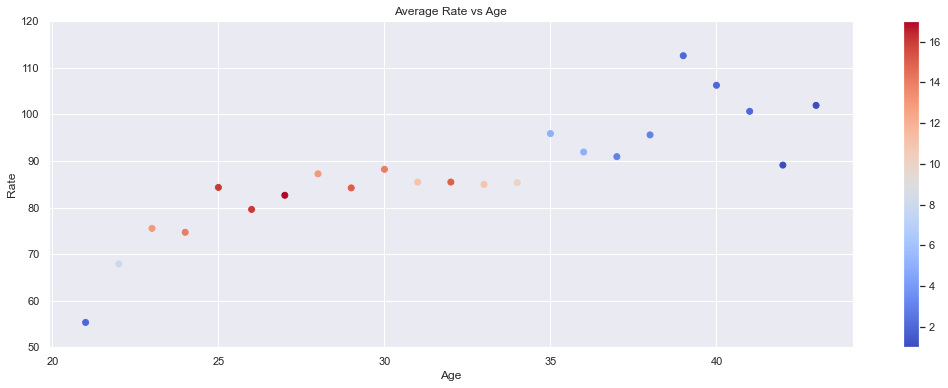
plot_avg_var_by_year(ctrl_avg, 'Rate')
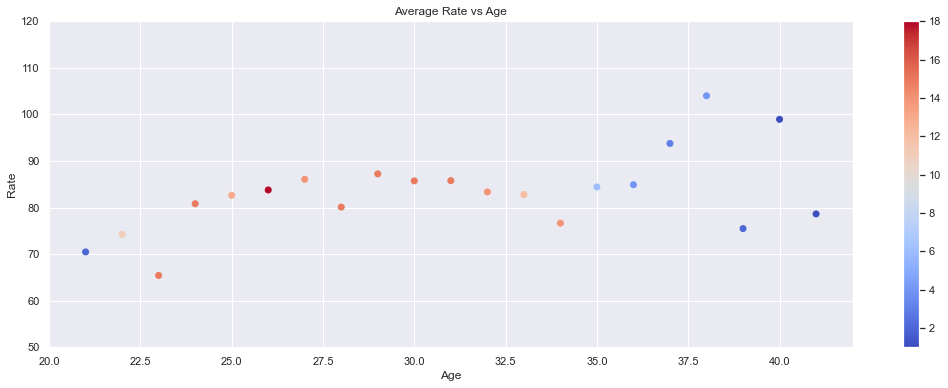
plot_avg_var_by_year(pop_avg, 'Rate')
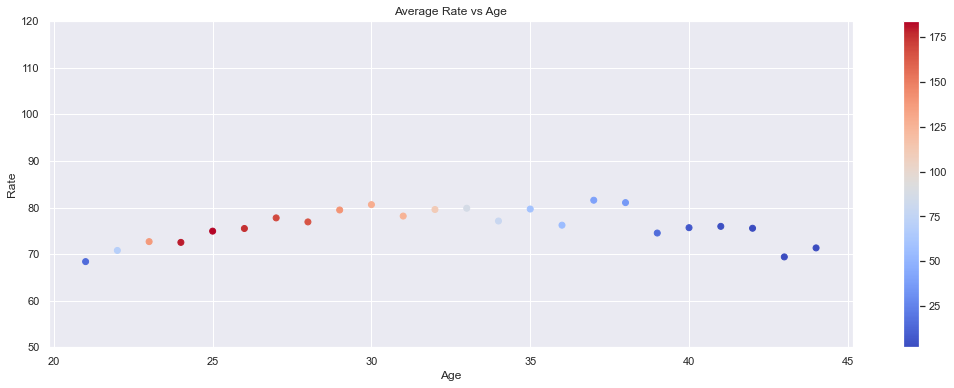
plot_case_ctrl_pop(case_avg, ctrl_avg, pop_avg, 'Rate')
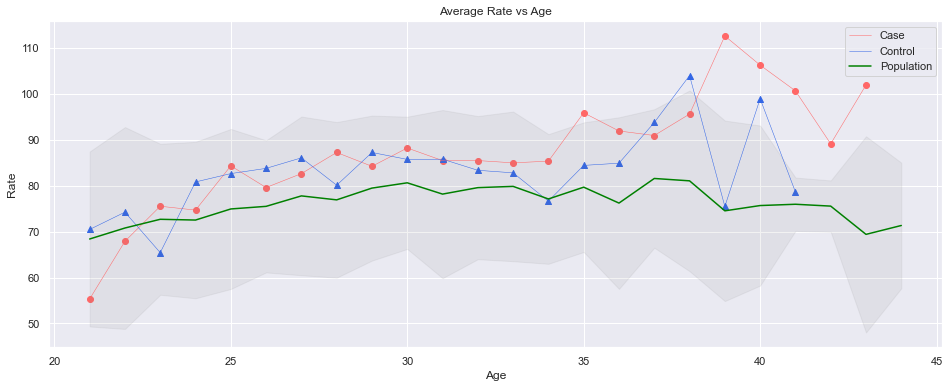
plot_case_control_by_year(case_qbs, select_ctrls, 'Rate');

References
Enger M, Skjaker SA, Nordsletten L, et al. Sports-related acute shoulder injuries in an urban population. BMJ Open Sport Exerc Med. 2019;5(1):e000551. Published 2019 Aug 12. doi:10.1136/bmjsem-2019-000551
Gibbs DB, Lynch TS, Nuber ED, Nuber GW. Common Shoulder Injuries in American Football Athletes. Curr Sports Med Rep. 2015 Sep-Oct;14(5):413-9. doi: 10.1249/JSR.0000000000000190. PMID: 26359844.
Hunter, J D. Matplotlib: A 2D Graphics Environment. Computing in Science & Engineering. 2007. 9, 90-95.
Kaplan LD, Flanigan DC, Norwig J, Jost P, Bradley J. Am J Sports Med. 2005 Aug; 33(8):1142-6.
Katz S, Burke B. How is Total QBR calculated? We explain our quarterback rating [Internet]. ESPN. 2016 [cited 2021May11]. Available from: https://www.espn.com/blog/statsinfo/post/_/id/123701/how-is-total-qbr-calculated-we-explain-our-quarterback-rating
Kelly BT, Barnes RP, Powell JW, Warren RF. Am J Sports Med. 2004 Mar; 32(2):328-31.
Knapp, Thomas R. and Schafer, William D. (2009) “From Gain Score t to ANCOVA F (and vice versa),” Practical Assessment, Research, and Evaluation: Vol. 14 , Article 6. DOI: https://doi.org/10.7275/yke1-k937
Lanzi JT Jr, Chandler PJ, Cameron KL, Bader JM, Owens BD. Epidemiology of Posterior Glenohumeral Instability in a Young Athletic Population. Am J Sports Med. 2017 Dec;45(14):3315-3321. doi: 10.1177/0363546517725067. Epub 2017 Sep 25. PMID: 28945456.
Monica J, Vredenburgh Z, Korsh J, Gatt C. Acute Shoulder Injuries in Adults. Am Fam Physician. 2016 Jul 15;94(2):119-27. PMID: 27419328.
Morgan, C J. Use of proper statistical techniques for research studies with small samples. Am J Physiol Lung Cell Mol Physiol. Oct 2017. 313, 873-877.
NCAA and NFL Passing Efficiency computation [Internet]. Stassen.com. [cited 2021May11]. Available from: http://football.stassen.com/pass-eff/
NFL Passer Rating Calculator [Internet]. ProFootballReference.com. Sports Reference LLC; [cited 2021May11]. Available from: https://www.pro-football-reference.com/about/qb-rating.htm
NFL Passer Rating Career Leaders [Internet]. Pro-Football-Reference.com. Sports Reference LLC; [cited 2021May11]. Available from: https://www.pro-football-reference.com/leaders/pass_rating_career.html
NFL’s Passer Rating [Internet]. Pro Football Hall of Fame Official Site. 2005 [cited 2021May11]. Available from: https://www.profootballhof.com/news/nfl-s-passer-rating/
NFL Quarterback Rating Formula [Internet]. QB Rating Calc - Help. NFL.com; 2011 [cited 2021May11]. Available from: https://web.archive.org/web/20110814052052/http://www.nfl.com/help/quarterbackratingformula
Pallis M, Cameron KL, Svoboda SJ, Owens BD. Epidemiology of acromioclavicular joint injury in young athletes. Am J Sports Med. 2012 Sep;40(9):2072-7. doi: 10.1177/0363546512450162. Epub 2012 Jun 15. PMID: 22707749.
Siwoff, S., & Zimmer, J. (2010). Inside the Numbers. In The Official National Football League Record and Fact Book 2010 (Vol. 91st Season, p. 312). Reference Book, National Football League.
Virtanen P, et al. SciPy 1.0: Fundamental Algorithms for Scientific Computing in Python. Nature Methods. 2020; 17(3), 261-272.

